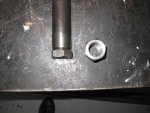OK now hold on here.
A tube, the same diameter and same grade steel, is not as strong as a round bar. It's stronger in tension, compession and shear loadings. All calculations use the area of the cross section. Period.

73CJ
Your absoutely right that an equally sized same grade bar versus a tube
may be stronger. But I have seen charts that show there is a break even point at a suggested wall thickness that can equal the same strength on an equal tube under certain tests.
But getting back to what I stated above was "any tubing that is sized correctly for the application is much stronger and lighter". That statement still holds true!
The conversastion was about Tie Rods and perhaps a Drag Link and the individual was talking about using cold rolled #1018 bar stock versus #1020 DOM tubing.
It is a well known fact that the weight to strength ratio is far better for a tube. This is simply because when you stress or bend a solid bar only the outer skin is actually stressed while the core is not contributing much strength at all.
In Bar Stock Metallurgial terms they refer to this as the 90/10 theory whereby the outer 10% bears 90% of the stress and the inner 90% only 10% of the strength, while in the case of the tube you remove a portion of the weight inside which was only contributing 10% of the strength , this is why a tube in the weight to strength ratio is much stronger simply because it retains only the material which contributes the most strength to the member and thereby creates the 4 wall theory.
The difference between the two metal grades mentioned above 1018 versus 1020?
The DOM tubing in Tensile & Yield Strength & Rockwell hardness alone exceed the cold rolled bar by over 8% in all departments. Notwithstanding the excellent memory of the tubing versus the Bar Stock makes this an easy choice.







